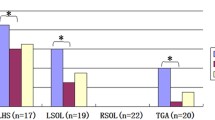Abstract
The study objective was to determine the effect of a patent ductus arteriosus (PDA) on cerebral blood flow velocity in ventilated, very low birth weight neonates, in the first 5 days of life. Sonography of the right middle cerebral artery and ductus arteriosus was performed using a colour Doppler technique. Statistical analysis was by stepwise regression. Thirty-one neonates without and 43 with a PDA, mean (SD) birth weight 1004 g ± 192 and 1071 g ± 227 respectively, were studied. The end diastolic and mean velocities were reduced (P = 0.008 and P = 0.129) and the resistive index was increased (P = 0.047) by a PDA. pH was inversely related to end diastolic and mean velocities (P = 0.015 and P = 0.003), suggesting that low pH may increase cerebral artery blood flow velocity.
Conclusion A patent ductus arteriosus reduces middle cerebral artery blood flow velocity in very low birth weight neonates.
Similar content being viewed by others
Author information
Authors and Affiliations
Additional information
Received: 7 March 1997 / Accepted in revised form: 15 May 1998
Rights and permissions
About this article
Cite this article
Weir, F., Ohlsson, A., Myhr, T. et al. A patent ductus arteriosus is associated with reduced middle cerebral artery blood flow velocity. Eur J Pediatr 158, 484–487 (1999). https://doi.org/10.1007/s004310051125
Issue Date:
DOI: https://doi.org/10.1007/s004310051125




